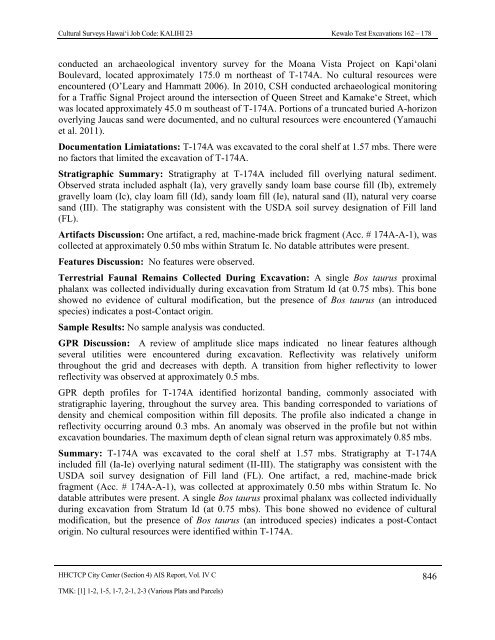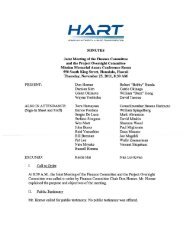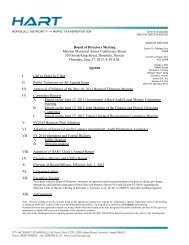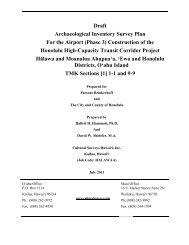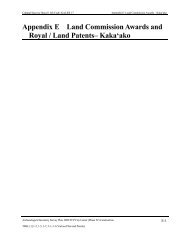4.12 Test Excavation 167 (T-167) - Honolulu Rail Transit Project
4.12 Test Excavation 167 (T-167) - Honolulu Rail Transit Project
4.12 Test Excavation 167 (T-167) - Honolulu Rail Transit Project
Create successful ePaper yourself
Turn your PDF publications into a flip-book with our unique Google optimized e-Paper software.
Cultural Surveys Hawai‘i Job Code: KALIHI 23 Kewalo <strong>Test</strong> <strong>Excavation</strong>s 162 – 178conducted an archaeological inventory survey for the Moana Vista <strong>Project</strong> on Kapi‘olaniBoulevard, located approximately 175.0 m northeast of T-174A. No cultural resources wereencountered (O’Leary and Hammatt 2006). In 2010, CSH conducted archaeological monitoringfor a Traffic Signal <strong>Project</strong> around the intersection of Queen Street and Kamake‘e Street, whichwas located approximately 45.0 m southeast of T-174A. Portions of a truncated buried A-horizonoverlying Jaucas sand were documented, and no cultural resources were encountered (Yamauchiet al. 2011).Documentation Limiatations: T-174A was excavated to the coral shelf at 1.57 mbs. There wereno factors that limited the excavation of T-174A.Stratigraphic Summary: Stratigraphy at T-174A included fill overlying natural sediment.Observed strata included asphalt (Ia), very gravelly sandy loam base course fill (Ib), extremelygravelly loam (Ic), clay loam fill (Id), sandy loam fill (Ie), natural sand (II), natural very coarsesand (III). The statigraphy was consistent with the USDA soil survey designation of Fill land(FL).Artifacts Discussion: One artifact, a red, machine-made brick fragment (Acc. # 174A-A-1), wascollected at approximately 0.50 mbs within Stratum Ic. No datable attributes were present.Features Discussion: No features were observed.Terrestrial Faunal Remains Collected During <strong>Excavation</strong>: A single Bos taurus proximalphalanx was collected individually during excavation from Stratum Id (at 0.75 mbs). This boneshowed no evidence of cultural modification, but the presence of Bos taurus (an introducedspecies) indicates a post-Contact origin.Sample Results: No sample analysis was conducted.GPR Discussion: A review of amplitude slice maps indicated no linear features althoughseveral utilities were encountered during excavation. Reflectivity was relatively uniformthroughout the grid and decreases with depth. A transition from higher reflectivity to lowerreflectivity was observed at approximately 0.5 mbs.GPR depth profiles for T-174A identified horizontal banding, commonly associated withstratigraphic layering, throughout the survey area. This banding corresponded to variations ofdensity and chemical composition within fill deposits. The profile also indicated a change inreflectivity occurring around 0.3 mbs. An anomaly was observed in the profile but not withinexcavation boundaries. The maximum depth of clean signal return was approximately 0.85 mbs.Summary: T-174A was excavated to the coral shelf at 1.57 mbs. Stratigraphy at T-174Aincluded fill (Ia-Ie) overlying natural sediment (II-III). The statigraphy was consistent with theUSDA soil survey designation of Fill land (FL). One artifact, a red, machine-made brickfragment (Acc. # 174A-A-1), was collected at approximately 0.50 mbs within Stratum Ic. Nodatable attributes were present. A single Bos taurus proximal phalanx was collected individuallyduring excavation from Stratum Id (at 0.75 mbs). This bone showed no evidence of culturalmodification, but the presence of Bos taurus (an introduced species) indicates a post-Contactorigin. No cultural resources were identified within T-174A.HHCTCP City Center (Section 4) AIS Report, Vol. IV C 846TMK: [1] 1-2, 1-5, 1-7, 2-1, 2-3 (Various Plats and Parcels)


